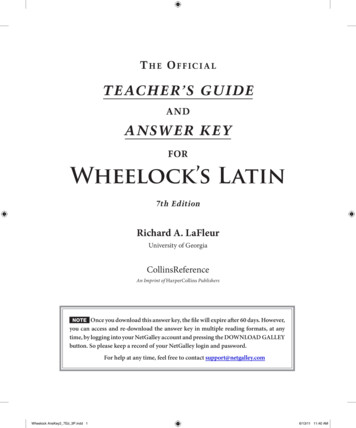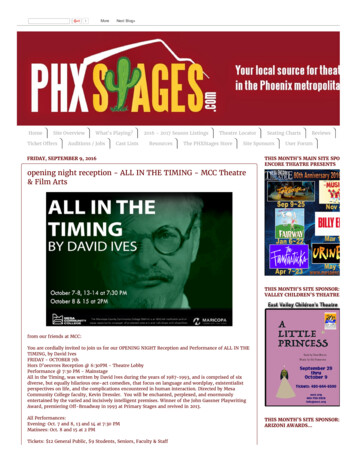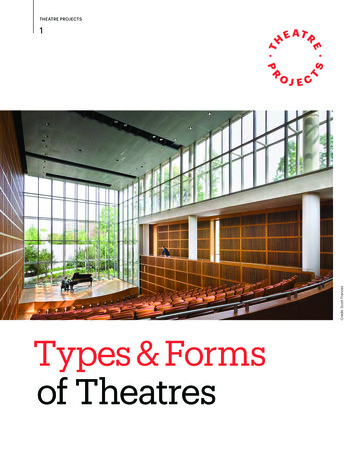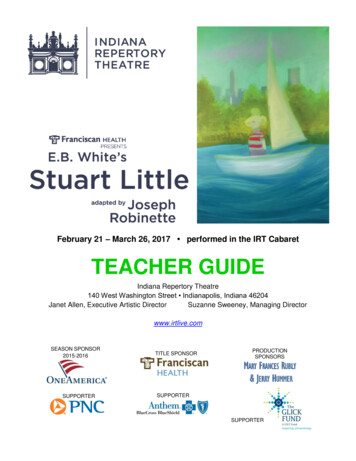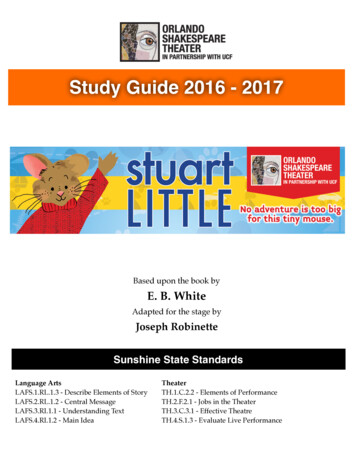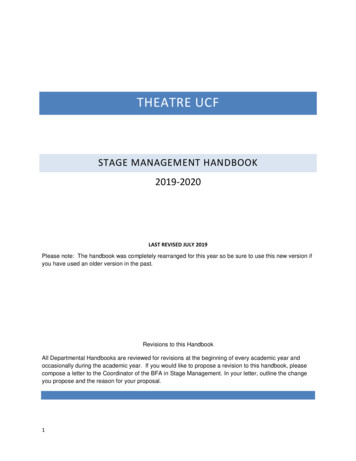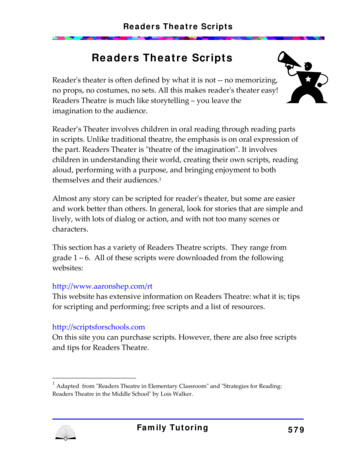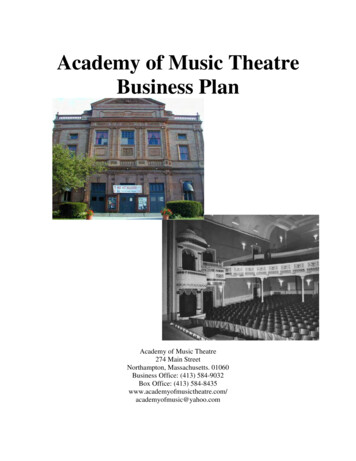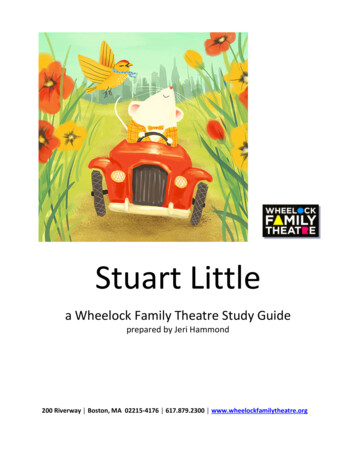
Transcription
Stuart Littlea Wheelock Family Theatre Study Guideprepared by Jeri Hammond200 Riverway Boston, MA 02215-4176 617.879.2300 www.wheelockfamilytheatre.org
BEFORE THE CURTAIN RISESRead Stuart Little by E.B. White. Ask students to make predictionsabout the play they’re going to see based upon their knowledgeof the source text as well as any other works by E.B. White. Forexample, not every character in the book appears in the play.Discuss: Which characters do you expect to see onstage? How do you imagine the locations will be createdonstage? How do you imagine the scenery, costumes and props? Will there be music? If so, how will it sound? What challenges do you think the designers had to meetin creating the world of Stuart Little?About the PlaySummaryStuart Little, “the second son of Mr. and Mrs. Frederick C. Little of New York City,” is a mouse.His family is full-sized and human, but the differences between them don’t stop them fromhaving a happy life. In fact, many of Stuart’s “differences” turn out to be uniquely helpful to hisfamily and friends. It’s his special capabilities as a mouse that help him in his journey to save hisbest friend Margalo, a beautiful and wise bird. The adventure wouldn’t be complete withoutobstacles, all of which challenge Stuart and help him grow. In this production, we don’t knowwhat adventures yet lie ahead for Stuart on his search for Margalo—it’s up to the viewer toimagine the ending for themselves!About the AuthorE.B. White“Many years ago,” E.B. White would say, “I wentto bed one night in a railway sleeping car, andduring the night I dreamed about a tiny boy whoacted rather like a mouse. That's how the story ofStuart Little got started.” Wheelock Family Theatre 2018 ǀ 1
Elwyn Brooks White was born in Mount Vernon, New York in 1899. For many years, he wascontributing editor of The New Yorker magazine. However, E. B. White is best known for hischildren’s books. The character of Stuart Little first appeared to E. B. White in a dream in the1920’s. White wrote a few episodes about this boy who looked like a mouse and then tuckedthe stories away in a drawer, thinking he might someday share them with his nieces andnephews. Some twenty years later he expanded and collected the stories as Stuart Little,published in 1945. It was White’s first children’s book. Hissecond was Charlotte’s Web, in 1952, which is one of themost popular children’s books of all time and was named “thebest American children’s book of the past two hundred years”by The Children’s Literature Association. From 1933, E.B.White lived on a farm in Maine with his wife Katharine. Hedied in 1985.Find out more about E.B. White by reading a biographysuch as this one!About the PlaywrightJoseph RobinetteJoseph Robinette is the author or co-author of 44published plays and musicals, including The PaperChase, Anne of Green Gables, Stuart Little, TheChocolate War, A Rose for Emily, and The Lion, theWitch and the Wardrobe. He collaborated with E.B.White on the authorized stage version ofCharlotte's Web, and with composer CharlesStrouse on the musical version. Robinette's playshave been presented by Lincoln Center, theGoodman Theatre, Stage One of Louisville and theHonolulu Theatre for Youth. His works have beenproduced in all 50 states and in several foreigncountries, including Germany, Spain, England, and South Africa. Robinette is the recipient ofnumerous awards including the Charlotte B. Chorpenning Award for a distinguished body ofwork. He is a member of the American Society of Composers, Authors and Publishers and is afounding member of Opera for Youth. In 2002, as professor of theatre at Rowan University, hereceived the Lindback Distinguished Teaching Award for Demonstrated Excellence in theUniversity Classroom. Wheelock Family Theatre 2018 ǀ 2
About the GenreStuart Little fits into the theatrical category of fantasy. The world of the play is very differentfrom our own world. While some of the characters are like us—Mr. and Mrs. Little, George, Dr.Carey—many are very different from us. Things happen in the play that don’t happen in reallife. In the world of Stuart Little animals talk, drive cars, teach classes, and wear human clothes.This does not happen in our world, but it is fun to imagine what it might be like if it did. Can you think of other stories in which animals act like humans? Or where humansbehave like animals?About Adaptation: From Page to StageHow does one become a tiny mouse in a play? When we use our imaginations, it’s easy topicture Stuart as small. On stage that can be harder to achieve. One way we do this is throughthe size of the objects in Stuart’s world. As you watch the play, notice that some objects arevery large and some are very small. Look for things that help show Stuart’s small size.About the ThemesA THEME is the main idea of the play, or what the play is about. Stuart Little explores manythemes—friendship, adventure, loyalty, helping others, overcoming things that are difficult forus. What do YOU think Stuart Little is about? What are some examples from the story that show you what the theme is? Wheelock Family Theatre 2018 ǀ 3
You’re As Big As You FeelStuart is different from the rest of hisfamily because he is a mouse. But henever lets that bother him. In fact,Stuart learns that he has a lot to offerbecause he is different. For instance, heis able to fetch his mother’s weddingring when it falls down the drain and heis able to win the model boat race forDr. Carey. Throughout Stuart’sadventures we see him face challengesthat we may not think he can tackle.Each time we learn that he’s just ascapable as anyone else.Photo Credit: Gary Thomas NgDiscuss:Stuart is proof that the way you think about a situation has a huge impact on its outcome. Have you ever experienced this in your life? How is saying I CAN different than saying I CAN’T?Stuart’s individuality is one of his greatest strengths. Because of his unique size, he’s able to doa lot of things his full-sized family can’t, and as a mouse he grows much faster than humanchildren. What are some things that make you different? Is there anything you can do that your friends and family can’t? Think about the waysyour individuality and unique talents are your strengths.At the beginning of the play, Mrs. Little points out that Stuart will be a great help to his parents.Mr. Little says this is “because he’ll be able to do things a mouse can do.” In this way, Stuart’ssize is a unique advantage. What unique things is Stuart able to help with because he is small? What are some unique ways that you can help others? Wheelock Family Theatre 2018 ǀ 4
Try It On For Size!Though Stuart’s size might make some human-sized tasks more difficult, with his friends’ andfamily’s help he can participate in plenty of regular activities. Using the ice skates made frompaperclips as inspiration, think of something you would create for Stuart so he might participatein an activity you like! Make a drawing or model of your idea.Think about using a real-world object in a totally different way. Assemble a collection ofcommon objects—cardboard tubes, hula hoops—and improvise as many different uses or newidentities for them as you can.Play This Is Not A Pass an object such as a cardboard tube around the circle. Each studenttransforms the tube into something else. “This is NOT a cardboard tube, it is a telescope a hotdog . A toothbrush ” How many ideas can you come up with?What ways did actors in the play use objects in unexpected or creative ways?If you were Stuart Little’s size (2 inches, not counting the tail) . What size bed would you need? . How big would your car be? What about your toothbrush?See if you can come up withmeasurements of everything inStuart’s room that are scaled toStuart’s size.Photo Credit: Glenn Cook PhotographyMake a MOUSE HOUSE.Use a shoebox or other small box to create a miniature room. Perhaps a spool of thread is atable or the possibilities are as BIG as your imagination. Wheelock Family Theatre 2018 ǀ 5
Dramatize Size!Imagine you’re the size of an ant and you’re in a bowl filled with sugar cubes. How would thatappear to you? Dramatize an ant’s climbing adventure in the sugar bowl or swimmingexperience in a teacup. Now imagine you’re a giant. Objects in your world would now seemvery small. How would a giant brush his teeth? Have a snack?Read some other books that feature characters different in size:Some very smallAnd some very large Wheelock Family Theatre 2018 ǀ 6
Friendship and FriendsThroughout his journey, Stuart meets many different people and makes friends very easily. Hemakes friends old and young, short and tall, bird and human. He also helps his friends out alongthe way. He gives some of his medicine to Margalo, wins a boat race for Dr. Carey, and teachesa class for the Superintendent of Schools. Stuart sets a great example of friendship and helpingothers.Activity:Write or improvise a scene between Snowbell and Stuart where Stuart is successful in winningSnowbell as his friend. Be clear about why Snowbell has a change of heart. Perform your scenefor the class “in character.”Discuss:Friendship is a very important theme in Stuart Little. Discuss the various examples of friendshipfound throughout the story and how friendship affects each of the characters differently. Stuart seems to easily make friends wherever he goes (with the exception of most cats).Why do you think Stuart can make friends so easily? What clear friendships do we see throughout the play? How do you think thesefriendships developed? What do these characters have in common that helps theirrelationship? Stuart’s best friend is Margalo and he’s also friends with different humans. Why do youthink it doesn’t matter that they’re different types of animals? Think about your friendships. Have you always been friends with these people? Haveyou had to overcome differences to be or stay friends? What does it mean to be a true friend? Wheelock Family Theatre 2018 ǀ 7
Character TraitsTo better understand the characters in a play, book, or movie, it’s helpful to examine their keycharacter traits—what qualities make these characters the way they are? Match the charactersfrom the play with character traits that best describe them and support their actions. Aselection of qualities is provided below and you can always add your own! Students can analyzeone character or all of them, and should support their ideas with evidence from the play orobservations they made about the character.Characters:Stuart LittleMargaloSnowbellMr. Little Mrs.Little GeorgeLittle Angi the caringcunningbraveCreate a Venn Diagram to compare characters.FamilyThe Little Family is a veryinteresting kind of family. What does it mean tobe a family? List words thatdescribe your family.Photo Credit: Glenn Cook Photography Wheelock Family Theatre 2018 ǀ 8
AFTER THE CURTAIN CLOSES“.this is where the story ends, butit’s also where our imaginationsbegin.”Encourage students to fill in the next chapter ofStuart Little’s adventure! In a collaborative effort orindividual assignments, have your students supplythe ending to Stuart’s adventure—or even just thenext step in his journey!When the play ends, Stuart is still searching for Margalo. Do you think he ever finds her?Pretend you are Margalo. Write a postcard to Stuart telling him about your travels. Draw apicture on the front of the card and write a letter on the back.Create a daily journal for Margalo describing the places she is visiting. Decide whether shewent north or south. Describe her adventures.Together, as a class, brainstorm possible endings to the play. Then have each student choose anoption and write out a 1 - 2 page scene with dialogue. Be sure to include stage directions forthe actors.Make a Stuart-sized book about his adventures.Discuss: How was the play different from the book?How was it similar?How did the actors look? Was it what you expected?Did the actors portray the characters as you thought they would?How did the stage look? Was it what you expected?How, when, where, and in what creative ways did the artists convey differences in sizeand scale?How did the director’s choice to have the actors play instruments on the stage help totell the story? Wheelock Family Theatre 2018 ǀ 9
Compare and contrast media: How are the book, play, and movie the same? How are they different?Read all three of these wonderful books by E.B. White! Wheelock Family Theatre 2018 ǀ 10
The character of Stuart Little first appeared to E. B. White in a dream in the 1920’s. White wrote a few episodes about this boy who looked like a mouse and then tucked the stories away in a drawer, thinking he might someday share them with his nieces and nephews. Some twenty years later he expanded and collected the stories as Stuart Little,

